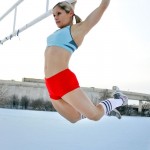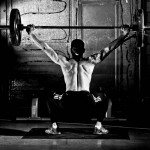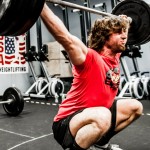Brian Schiff’s Blog
Injury Prevention, Sports Rehab & Performance Training Expert
The last two weeks I have continued to see progress with my strength. My “shrug sign” lifting up my left arm is improving and now most noticeable when lifting my arm out to the side at 80 degrees and beyond. I have seen a steady increase in lifting capacity for my biceps and triceps but am still down more than 50% compared to my right side overall in strength.
New accomplishments
- Able to reach behind my head and wash my hair
- Able to drive and turn the steering wheel with just my left arm
- Begin wall push-ups and single arm rows
Remaining limitations
- Reaching up behind my back
- Unable to lay/sleep on left side
- Decreased elevation and external rotation
I have learned that the shoulder is still vulnerable if I do too much activity or push it too hard with the stretching. Generally, I stick to no more than 4/10 pain when doing passive stretching myself. In therapy, I have been just trying to block out the pain and endure the stretching even when it goes beyond that level. Last week, I had difficulty sleeping the same night following both of my PT sessions. I felt as if the PROM performed by the PT was more intense than it has been. While I was able to tolerate it during the session, the shoulder was increasingly sore and tight the same day after both sessions.
Well, I just saw my surgeon as I approach the 11 week post-op mark. I have made good progress since the steroid injection. Although I am still a little stiffer than we both would like, my ROM is progressing and my pain is gone aside from when I or my therapist really stretch it into end range.
Activities of daily living
I am now doing most things (bathing, dressing, grooming, etc.) using my left arm. It was a big deal when I could use my left arm in the drive through and ATM again lol. We tend to take the little things for granted until we cannot do them. I can turn the steering wheel with my left arm, although I will admit it is still a little challenging and fatiguing. Carrying light groceries is no sweat, and I have even started mowing my lawn with a self propelled lawn mower. Keep in mind my yard is flat and relatively small, so I would probably advise most patients to wait a bit longer on that.
Rehab recap
The past two weeks I have continued focusing on AROM and PROM while slowly progressing my strengthening exercises. My typical rehab session looks something like this:
- Heat x 10 min
- Active assistive cane ROM exercises x 20 each
- Pulley: 2 x 15
- Wall slides x 20
- UBE x 6 min
- PROM by PT for 20-30 min
- Serratus punches – 2 x 10
- Theraband rows and pulls – 2 x 10-15
- Theraband internal rotation – 2 xx 10
- Theraband external rotation walk outs – 2 x 10
- Side-lying external rotation (no weight) – 2 x 10
- Stabilization on the wall with a ball (up/down, side-to-side, circles) 2 x 10
- Prone extension (light weight) – 2 x 10
- Prone horizontal abduction (no weight) – 2 x 10
- Standing flexion and scaption (0-1#) 2 x 10 focusing on no shrug in my range of motion
- Ice x 10 min
The entire session takes about 90 minutes. Of course, I am navigating all the exercises on my own and relying on a colleague to do the PROM. With respect to the strengthening, my focus is on form, time under tension, avoiding excessive upper trap and compensatory motion, and ensuring I am not experiencing pain as I move the arm.
SLAP tears are a common problem for overhead athletes among others today. There is no consensus per se in how to treat them and results following primary repair are mixed. Common complaints following a repair are persistent pain and stiffness. In the past, I have writtne about SLAP tears as well as outcomes for elite pitchers.
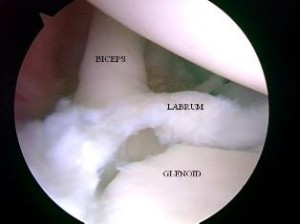
In addition, I have discussed outcomes for type 2 SLAP tear revision surgery on this blog. What always concerns me (and more importantly patients who undergo surgery is how to achieve predictable pain relief and recover shoulder function. In the April 2014 edition of the American Journal of Sports Medicine, there is a level 4 prospective study by McCormick et al. looking at the efficacy of subpectoral biceps tenodesis as a viable solution for failed primary SLAP repairs. The study took place from 2006-2010 and all procedures were performed by 2 fellowship trained surgeons at a tertiary military facility.
Subjects: Active-duty men and women b/w 18 and 50 years old who had arthroscopically confirmed type 2 SLAP lesions and who then underwent arthroscopic repair and were subsequently unable to return to duty(follow-up period was 2-6 yeaers with mean follow-up of 3.5 years). They also had to consent to a biceps tenodesis to address the failed repair. All told, 42 of 46 patients completed the study. The mean age was 39.2, while 85% of the subjects were male.
Criteria to be included in the study: inability to return to active duty within a minimum 6 months of surgery, ASES score less than 75 at 1 year follow-up from the primary procedure, or patient electing to undergo revision surgery due to dissatisfaction with the primary results.
Procedure: Biceps tendon was released and the remaining stump was debrided so the superior labrum was confluent with the remaining labral tissue. All sutures and loose anchors were removed. If the rotator cuff interval was inflamed, debridement with a 4.o mm shaver was used and/or radiofrequency wand was used. Next, a 2 cm incision was made in the axillary skin crease at the inferior border of the pec major. The biceps tendon was anchored 1 cm proximal to the musculotendinous junction using a nonabsorbable suture and 8 x 12 interference anchor fixation.
Rehab protocol: Patients were in a sling for 4 weeks with no active biceps use for 6 weeks. They all underwent graded supervised physical therapy consisting of an initial 6-week phase of passive ROM exercise in addition to scapular and core strengthening. This was followed by progressive strengthening at 6 weeks and return to-duty-evaluation at 3 months post-op.
Results
- 34 patients (81%) returned to active duty
- Clinically significant improvement across all outcome measures after revision surgery as follows:
- Pre-op ASES = 68 and post-op ASES = 89
- Pre-op SANE = 64 and post-op SANE = 84
- Pre-op WOSI = 65 and post-op WOSI = 81
- Pre-op shoulder flexion = 135 and post-op shoulder flexion = 155
- Pre-op shoulder abduction = 125 and post-op shoulder abduction = 155
Summary
Currently, there is no standard of care for failed SLAP repairs. One previous case control study by Boileau et al. found higher satisfaction in those undergoing biceps tenodesis compared to arthroscopic repair in the management of an isolated SLAP tear. Further, in the Boileau study there were no failed tenodesis procedures and those opting for that as revision had a full return to previous sports activity. This prospective study by McCormick et al. resulted in similarly high rates of return to previous activity and clinically significant improvements in outcome scores and ROM.
There are several reasons why primary SLAP repairs may fail including: postoperative stiffness as a result inadvertent restriction of physiological biceps excursion or nonanatomic biceps anchor reduction, suture anchor pullout, suture granuloma formation, suture pullout, synovitis, glenoid osteochondrolysis from prominent hardware, a suprascapular nerve injury (due to prominent mendial hardware placement), and a delaminated long head of the biceps.
It is also important to keep in mind the anterior-superior labrum and glenoid are poorly vascularized, and this is thought to limit the healing process. Persistent pain may manifest after surgery in light of the fact the proximal intra-articular portion of the long head of biceps tendon contains sensory and sympathetic fibers associated with shoulder pain. The authors’ findings at the revision procedure in this study suggest a consistent constellation of multifactorial complicating factors including: synovitis of the rotator cuff interval, loose knots, and a lack of healing at the glenoid interface.
Key takeaways
- Outcomes following primary SLAP repairs are inconsistent and patients often continue to c/o persistent pain and stiffness
- Military personnel (an extremely active population) had excellent results with a tenodesis procedure
- The results of this study cannot be generalized to the general public nor overhead athletes per se
- This study did not employ randomization nor did it compare the tenodesis to another procedure/modality so further research should be done on this
- Biceps tenodesis seems to provide a safe and effective treatment option for failed SLAP repairs at a minimum of a 2 year follow-up in active individuals
References
Boileua et al. Arthroscopic treatment of isolated type II SLAP lesions: biceps tenodesis as an alternative to reinsertion. Am J Sports Med. 2009;37(5):929-936.
McCormick et al. The efficacy of biceps tenodesis in the treatment of failed superior labral anterior posterior repairs. Am J Sports Med. 2014;(42):820-825.
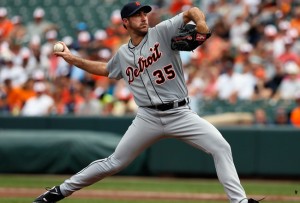
Photo from Bleacher Report
Shoulder surgery is a big concern for any professional pitcher. I am currently rehabbing two MLB pitchers (one from a labral repair and the other from a Tommy John procedure and obviously not JV pictured above). They are doing great so far in their early rehab, but time will tell if they make it back to their pre-injury pitching levels.
Overuse injuries in youth baseball players is always a huge concern I have. In fact, I speculate that early wear and tear may contribute to injuries seen down the road in HS, college or the pro ranks. I know from coaching and observing that more youth coaches need to familiarize themselves with pitch count guidelines and rest/recovery recommendations that Little League baseball now endorses.
As a sports physical therapist who sees 12 year-olds with RC problems and torn UCLs and as a father/coach of a 10 y/o left-handed pitcher, I have a strong passion and vested interest in the welfare of baseball pitchers. While research does not equate increased injury risk with throwing curveballs and sliders to date per se, both of my MLB clients advise against it until athletes turn 14 or 15.
For information on injury prevention and pitching guidelines for youth, check out this website:
http://www.asmi.org/research.php?page=research§ion=positionStatement
Today’s blog post focuses on outcomes following surgery for elite pitchers. The following information was just published in the Jul/Aug 2013 edition of Sports Health by Harris et al. based on literature review based on these outcome measures:
Primary = pitcher’s rate of return to sport (RTS) at the same level prior to injury
Secondary = rates of RTS regardless of level, performance upon RTS and clinical outcome scores
“Elite” was defined as throwing in at least one game in MLB, minor league (A, AA, or AAA) or all collegiate divisions. Six level I-IV studies were included with enrollment from 1976 – 2007, and there were 287 elite male pitchers who underwent shoulder surgery with 99% on the dominant throwing shoulder. Most pitchers (276) were professional with a mean career length of 6.58 years. Post-operative clinical follow-up within these studies was 3.62 years.
Primary diagnoses treated:
- RC tear = 120 (43%)
- Internal impingement = 82 (30%)
- Labral tear = 74 (27%)
Surgical procedures performed:
- Labral repair (157) or labral debridement (99)
- RC repair (29) or debridement (162)
- Thermal capsulorrhaphy (63)
- Subacromial decompression (42)
The statistics reveal more debridement of the labrum (61%) and rotator cuff (85%) versus repair. This is not necessarily surprising given the desire to minimize surgical intervention and loss of motion.
Return to Sport Data
- The overall rate of return to sport was low at 68%.
- Mean time to return to competitive pitching in a game situation was 12 months (range = 9 -17)
- 22% of MLB pitchers never pitched again in MLB
- Only 14% returned to competitive pitching in the same season as labral surgery
- No one returned to competitive pitching in the same season after rotator cuff surgery
- Reynolds et al reported a median of 2 seasons of pitching after debridement of partial thickness cuff tears
- Mazoue and Andrews reported a mean of 0.7 seasons pitching (range 3 innings to 3 seasons) after mini-open RC repair
Performance declined for the 3 seasons prior to surgery and then gradually increased for 3 seasons afterward, but generally did not reach pre-injury levels.
So, I treat a number of fitness enthusiasts in the clinic and many include Crossfit clients. Recently, I evaluated a 38 y/o male on 2/16/12 with a 3 month history of right shoulder pain. He performs Crossfit workouts 6 days per week. His initial intake revealed:
- Constant shoulder pain that worsens with overhead movements
- Pain with bar hangs, overhead squats and wide grip snatches
- Unable to do kipping (only doing strict form pull-ups)
- Pain if laying on his right side at night
- No c/o neck pain, referred pain or numbness/tingling
Notice the shoulder position during the kipping pull-up and overhead squat below. This is a position of heightened risk for the shoulder.
His exam revealed the following:
- Normal range of motion
- Strength within normal limits except for supraspinatus and external rotation graded 3+/5 with pain
- Positive impingement signs
- Negative shrug sign
- Negative Speed’s and O’Brien’s test
- Tender along distal supraspinatus tendon
Based on the clinical exam, it was apparent he had rotator cuff inflammation and perhaps even a tear. Keep in mind he had not seen a physician yet. I began treatment focused on scapular stabilization and rotator cuff strengthening as well as pec and posterior capsule stretching to address the impingement. Ultrasound and cryotherapy were used initially to reduce pain and inflammation.
One month following the eval
By 3/14/12, his pain was resolved with daily activity and he had returned to snatches and push-press exercises without pain. He still could not do overhead squats with the Olympic bar pain free, but he could with a pvc pipe. Strength was now 4/5 for supraspinatus and 4+/5 for external rotation. All impingement tests were now negative as were Speed’s and O’Brien’s testing.

